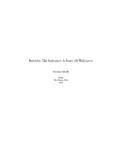Transcription of Thick-Walled Cylinders and Press Fits
1 2004 by : Thick-Walled Cylinders and Press Fits1 2004 by :Stresses in Thick-Walled Cylinders Thick-Walled Cylinders have an average radius less than 20 times the wall thickness. They are pressurized internally and/or externally. The principal stresses are circumferential (hoop) c, radial r, and longitudinal (axial) r l c2 2004 by :Circumferential & Radial Stresses2222222/)(iooioiooiirrRrrppprpr = For the general case of bothinternal and external pressure, the circumferential and radial stresses at radius R in the wall are: =222221 Rrrrproioii For the special case of only internal pressure, po= 0, and the stresses at radius R are:The sign convention is the the is: + for circumferential, and-for radial stress. 2004 by :Longitudinal Stresses222ioiilrrrp = The longitudinal stress is simply given by a Force/Area, where the Force is pitimes the circular inside area ri2 , and the Area is the annular area of the cylinder cross section, ( ro2 -ri2) , or:This is generally only considered for the case of internal pressurization ( po= 0).
2 RiropopiR r l c4Un-numbered Equation just below Eqn. 2004 by :Stresses vs. RadiusFirst, the easy observation: Radial stresses at the inner and outer surfaces are equal to minus the pressurization. If a surface is unpressurized, the radial stress there is zero. If a surface is pressurized, the radial stress there = -p, because it is in compression. =222221 Rrrrproioii Now let s look at an internally pressurized cylinder , and how the radial and circumferential stresses vary across the wall thickness at radius R.( + is circumferential, -is radial ) 2004 by : Thick-Walled cylinder with internalpressure of 5330 (in.)Stress (KSI)RADIAL STRESSHOOP STRESSS tresses for Internal Pressurization6( + is hoop, -is radial ) =222221 Rrrrproioii 2004 by :Stresses vs.
3 Radius -Internal PressureRadialstress is as predicted: -5330 psiat the inner, pressurized surface. 0 at the unpressurizedouter is: Maximum at the inner surface, ksi. Lower, but not zero, at the unpressurizedouter surface, ksi. Larger in magnitude than the radial stressLongitudinalstress is (trust me): ksi, considered as a uniform, average stress across the thickness of the let s look at an externally pressurized 2004 by : Thick-Walled cylinder with externalpressure of 5330 STRESSHOOP (in.)Stress (KSI)Stresses for External Pressurization =222221 Rrrrpriiooo ( + is hoop, -is radial )8 2004 by :Stresses vs. Radius -External PressureRadialstress is as predicted: 0 at the unpressurizedinner surface. -5330 psiat the outer, pressurized is: Minimum at the outer surface, ksi.
4 Maximum at the (unpressurized) inner surface, ksi. Larger than the radial stressLongitudinalstress is: Not usually considered for external 2004 by : Press Fits10In a Press fit, the shaft is compressed and the hub is interference, rHubShaft 2004 by : Press FitsPress fits, or interference fits, are similar to pressurized Cylinders in that the placement of an oversized shaft in an undersized hub results in a radial pressure at the 2004 by :Characteristics of Press Fits121) The shaft is compressed and the hub is ) There are equal and opposite pressures at the mating ) The relative amount of compression and expansion depends on the stiffness (elasticity and geometry) of the two ) The sum of the compression and the expansion equals the interference ) The critical stress location is usually the inner diameter of the hub, where max tensile hoop stress 2004 by :Analysis of Press FitsStart by finding the interface ()()() =22222222ioiorrrRrRRrREp Where ris the RADIAL interference for hub and shaft of the same material, with modulus of elasticity, the shaft is solid, ri= 0 and =2212orrRREp , , rearranged 2004 by.
5 Analysis of Press FitsIf the shaft and hub are of different materialsOnce we have the pressure, we can use the cylinder equations to compute the hoop stresses at the interface. ++ + +=iiiioooorRrRERRrRrERpr 22222222A) The ID of the hub is tensile:B) The OD of the shaft is compressive:2222 RrRrpoooc += 2222iicirRrRp + = = -p if shaft is , , iRrori i,o= PoissonEo, o 2004 by :Strain Analysis of Press FitsThe Press fit has no axial pressure, so l= 0, and it is a biaxial stress circumferential strainwhich equals the radial strain (because C = 2 r). Because the radial change = R r, we getthe increase in InnerRadiusof the outer member(hub):RroriAnd the decrease in OuterRadiusof the inner member( shaft ): EErcc = + +=oooooRrRrEpR 2222 + =iiiiirRrREpR 2004 by :Notes on Press FitsAs a check, make sure that The assembly force required will be Fmax= dLp where p = the interface pressure = the coefficient of frictionroi =+The torque capacity available is T =FR = R dLp where R = the interference radius, as conveniently know the interface pressure for these equations!
6 Td = 2 RLF16 2004 by :Shrink FitsIf heating or cooling a part to achieve a shrink fit, the required radial interference is: R = r= R Twhere R is the interface radius is the coefficient of thermal expansion T is the temperature changeTo select an amount of interference see ANSI/ASME tables for class FN1 (light) to FN5 (Heavy-drive) fits. They give interference in " on diameterfor a range of diametersEx: FN4 for to " diameter, interference = 1 to milson




